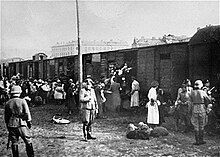| Revision as of 22:03, 2 August 2012 view sourceBoston9 (talk | contribs)Extended confirmed users1,936 edits picture update← Previous edit | Revision as of 21:16, 3 August 2012 view source Boston9 (talk | contribs)Extended confirmed users1,936 edits expanding articleNext edit → | ||
| Line 8: | Line 8: | ||
| The ''Umschlagplatz'' was created by fencing off a western part of the ] freight train station that was adjacent to the ghetto. The area was surrounded by a wooden fence, replaced later by a wall. Railway buildings and installations on the site as well as a former homeless shelter and a hospital were converted to the prisoner selection facility. The rest of the train station served its normal function for the rest of the city during the deportations. | The ''Umschlagplatz'' was created by fencing off a western part of the ] freight train station that was adjacent to the ghetto. The area was surrounded by a wooden fence, replaced later by a wall. Railway buildings and installations on the site as well as a former homeless shelter and a hospital were converted to the prisoner selection facility. The rest of the train station served its normal function for the rest of the city during the deportations. | ||
| ==Monument== | |||
| ⚫ | |||
| In 1988, on the 45th anniversary of the outbreak of ], a stone monument resembling an open freight car was unveiled to mark the ''Umschlagplatz''. The inscription on four commemorative plaques in Polish, ], English and ] reads: | |||
| ''Along this path of suffering and death over 300 000 Jews were driven in 1942-1943 from the Warsaw Ghetto to the gas chambers of the Nazi exterminantion camps.'' | |||
| 448 first most popular Jewish-Polish first names, in alphabetical order from Aba to Żanna, were engraved on the monument, each one commemorating 1,000 victims of the Warsaw Ghetto. The monument gate is surmounted by a granite grave stone (donated by the government and society of ]) with a motive of shattered forest - a symbol of the exterminantion of the Jewish nation. | |||
| ⚫ | The monument was created by architect Hanna Szmalenberg and sculptor Władysław Klamerus. | ||
| ==See also== | ==See also== | ||
Revision as of 21:16, 3 August 2012


In the Holocaust, the Umschlagplatz (Template:Lang-de) in the Warsaw Ghetto was where Jews gathered for deportation to the Treblinka extermination camp.
During the Grossaktion Warsaw, beginning on July 22, 1942, Jews were deported in crowded freight cars to Treblinka. On some days as many as 7,000 Jews were deported. An estimated 300,000 Jews were taken to the Treblinka gas chambers, and some sources describe it as the largest killing of any single community in World War II. The deportations ended on September 21, 1942.
The Umschlagplatz was created by fencing off a western part of the Warszawa Gdańska freight train station that was adjacent to the ghetto. The area was surrounded by a wooden fence, replaced later by a wall. Railway buildings and installations on the site as well as a former homeless shelter and a hospital were converted to the prisoner selection facility. The rest of the train station served its normal function for the rest of the city during the deportations.
Monument
In 1988, on the 45th anniversary of the outbreak of Warsaw Ghetto Uprising, a stone monument resembling an open freight car was unveiled to mark the Umschlagplatz. The inscription on four commemorative plaques in Polish, Yiddish, English and Hebrew reads:
Along this path of suffering and death over 300 000 Jews were driven in 1942-1943 from the Warsaw Ghetto to the gas chambers of the Nazi exterminantion camps.
448 first most popular Jewish-Polish first names, in alphabetical order from Aba to Żanna, were engraved on the monument, each one commemorating 1,000 victims of the Warsaw Ghetto. The monument gate is surmounted by a granite grave stone (donated by the government and society of Sweden) with a motive of shattered forest - a symbol of the exterminantion of the Jewish nation.
The monument was created by architect Hanna Szmalenberg and sculptor Władysław Klamerus.
See also
- Oyneg Shabbos chroniclers of the Warsaw Ghetto led by Emanuel Ringelblum
Bibliography
- Bernard Goldstein. Five Years in the Warsaw Ghetto. Dolphin, Doubleday. New York, 1961
- Emanuel Ringelblum. Kronika getta warszawskiego wrzesień 1939 - styczeń 1943. Warszawa 1988.
52°15′08″N 20°59′21″E / 52.2523083333°N 20.9890777778°E / 52.2523083333; 20.9890777778
This Warsaw-related article is a stub. You can help Misplaced Pages by expanding it. |
This article related to the Holocaust is a stub. You can help Misplaced Pages by expanding it. |